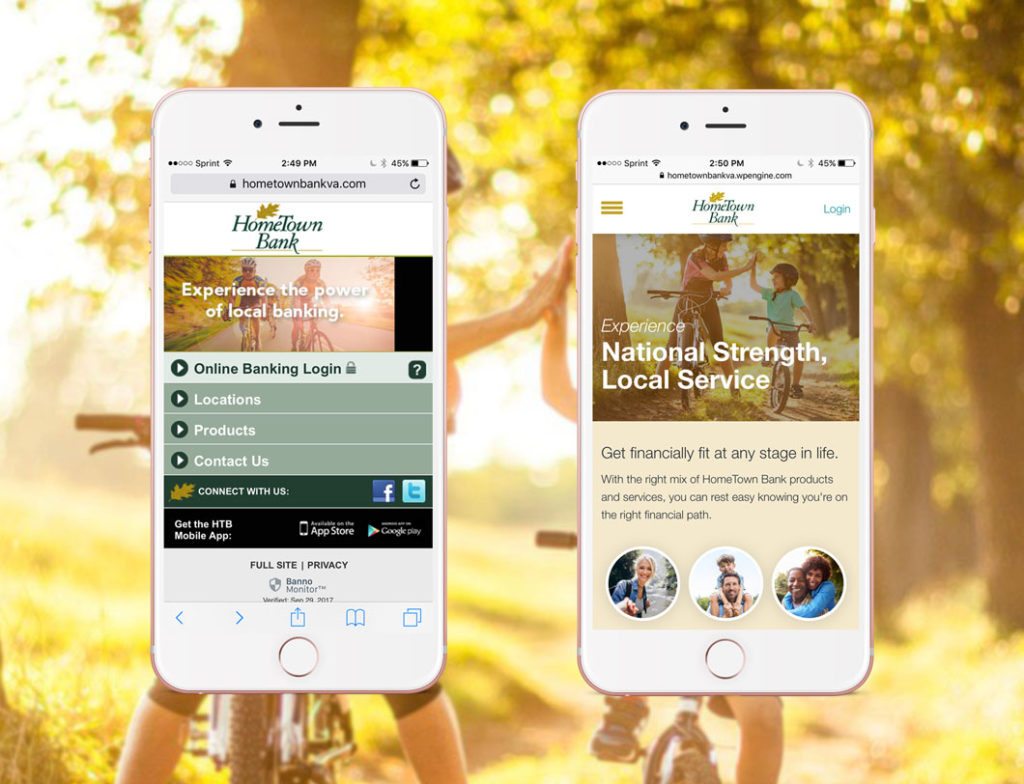Though the internet has been around for decades now, it has only really skyrocketed on the list of priorities for both businesses and consumers over the last 10 years or so. A lot of businesses are still catching up.
Raise your hand if you have ever felt personally victimized by a bad website.
Good.
Now raise your hand if a bad website gave you a bad impression of a brand. What about when you tweeted a complaint to a company, but they never answered? Or if they publish pixelated graphics to their Facebook page? See where I’m going with this?
Though the internet has been around for decades now, it has only really skyrocketed on the list of priorities for both businesses and consumers over the last 10 years or so. A lot of businesses are still catching up. Even some of our former clients are realizing the website we built for them 5 years ago has stale content or is not optimized for mobile because smartphones were only just starting to take off “way back when”.
If you haven’t hopped on the digital strategy train yet, take heed. You run a high risk of being left in the dust of an untouched website graveyard. With some brands taking digital as far as Virtual Reality and hologram demonstrations, consumers are looking to be engaged and entertained by brands and pretty soon, digital will be the only way to achieve that.
The Low Hanging Fruit: Social Media
If your business doesn’t have a Facebook page, does it really even exist?
Some say “of course it does”. But the majority of buying power now and in the future say “#duh”! Social media is one of the easiest ways to build a digital presence online because it’s essentially free. You can build a Facebook, Twitter, and Instagram account over the course of one afternoon at no cost but your time.
Consumers want to get to know brands before they buy a product and later use that relationship to affirm their choices after the purchase. As genuine trust in a company becomes a priority for consumers, using social media platforms is the best way to build that trust. They will want to see how you interact in the community, they want to hear about your core values, and they want to imagine your brand as a living, breathing organism with personality and real relationships. Social media is one of the best ways to showcase all of these things.
If you can’t be a social media master, prioritize these activities on your most important accounts:
Present A Positive Customer Service Experience
71% of consumers who have had a good social media service experience with a brand are likely to recommend it to others. (Source: Ambassador)
It’s not fun to deal with public complaints, no matter how valid or invalid they may be. However, it is vital to your reputation. A consumer may share their positive experience with others, but they’re even more likely to share a negative experience. As social media grows as a global means of communication, you’ll have to learn to communicate where and how your customers communicate. The best thing to do is identify any common themes in questions or comments to have some go-to answers that are accurate, have a solid brand voice, and provide a positive experience.

Show Off Your Personality
On social media, people want to be social! They don’t want to read a string of promotions and company information. They want to be entertained while they’re being educated and like to feel like they’re being heard. Reply to their comments, even if it’s simply a positive shoutout. Deliver your messages in different formats to keep things fresh. And when appropriate, have a little fun!
Even some of the more serious industries can define their brand voice to appear more personable than robotic. Knowing the appropriate time to drop in a clever quip or even a GIF will give you an online reputation as a real company with real people behind the scenes.

Stay Active but Not Annoying
Nothing inspires an “unfollow” faster than a company that posts 15 times a day (too much) or only posts once every few months (too little). Furthermore, it’s important to make sure what you’re sharing is purposeful, helpful, and appropriate for your audience.
Building out an editorial calendar can help find the balance in all of this. You can space out different types of content so that consumers don’t get bored or feel overloaded, you can plan out opportunities to post about timely topics that your audience will love, and having all of this planned out ahead of time will cut your management time in half!
Websites: Let the Analytics Speak
Your website should also serve as a tool for your business. It should get your business found through search rankings, exemplify your brand through visuals and content in a meaningful way, and deliver some form of customer service. If your website cannot deliver these three things, your online reputation will diminish quickly.
So how do you know if your website is working effectively for you and your customers? Google Analytics can paint a pretty clear picture. Setting up Google Analytics for your website is fast, free, and easy. It will quickly become one of the best tools you can use to guide your next steps in improving your digital presence. If your website shows a high bounce rate, low average time on page, or low conversion rate, it’s safe to assume that your website isn’t providing the best experience of your company to customers. These three metrics make it clear that they either aren’t finding the information they’re looking for or the overall experience isn’t enjoyable.
Secure Your Website
Nothing sends a website visitor straight towards the X button faster than an unsecured website warning. In an instant, a user can tell that you haven’t prioritized your digital presence enough to build a secure connection between your website and the internet.

A Security Sockets Layer (SSL) certificate, explained more in-depth in here, establishes a secure path for data to be passed between the servers and the browser. Browsers like Google Chrome are built to quickly identify and warn users that their connection to a website may not be secure and that any personal information delivered to the site could be compromised. This is certain to deter people from moving forward with viewing your website, and possibly from doing business with you. Whoever you host with should be able to help you secure your website, but if you’re having trouble, here is a quick guide:
Optimize Page Speed
Once you get past the security issue, a visitor to your website will still have a moment to decide whether they like you or trust you in the first 10 seconds of loading your home page. First of all, if your page takes longer than 10 seconds to load, you’ve already lost them. If you don’t have the technology to properly load your website, how can they trust you to have the means to serve your product or service correctly?
Large image files, excessive or out of date plugins, and bad coding are just a few ways the data transfer that is required for a browser to load a page gets bogged down. Making some small changes in the back end of your website can provide a major improvement in load time, ultimately providing your consumers with information as fast as they want it.

Try to resize or compress your images. If possible, keep your images under 300 kb in file size. When this is unavoidable, take advantage of compression plugins like WP-Smush. Faster loading images can make a big impact on your load time. As very visual creatures, visitors will be more engaged quickly when images aren’t lagging.
You can also take stock of your plugins. Are they all necessary? Are the up to date? Often times if you neglect to update your plugins, it can slow down your load speed because it’s working extra hard to service an older version. You can also consider prioritizing which plugins you really need. Our top 4 plug-in priorities include Yoast for SEO, GravityForms to provide a means of communication for visitors, WP Smush Pro to optimize images, and Sucuri Security to keep our visitors safe.
Reorganize Content
Sometimes the biggest problem with websites is that they don’t deliver the right information in the location that a user is looking. Whether it’s because the information is buried under multiple click-throughs to a third tier page or you categorized it differently, if they can’t find the information, they assume you haven’t provided it.
Looking at the “user flow” in Google Analytics can help you see the most common paths of navigation on your website. The time they spend on the last page before they leave can be a great indicator of whether they found what they were looking for or not. You can use this as a guide to reexamine how your website and navigation is laid out. Is it working for you or against you?
Sometimes it’s as easy as moving your FAQ section from the “About Us” to the “Customer Service” page. Sometimes you may even have pages that aren’t important to users and never get visited. With analytics, you can determine what information is most important to the users and work to deliver it in a more meaningful, effective way.
Complete Overhaul
Sometimes, the fix isn’t that simple. A single defining factor that determines whether your brand is viewed as a modern, viable company is whether your website is usable on a mobile phone. In 2017, mobile browsing surpassed desktop and laptop browsing by 5%, ranking it as the most popular method of browsing the internet (Source: We Are Social)
For a long time, building a separate mobile site was used as a stepping stone for this new screen size, but compared to modern, responsive websites, mobile sites still incite a reputation of being behind the times. Because there are so many different sizes of phones, tablets, and computer screens, a responsive website is key to digital strategy success. We recently overhauled the website for one of our favorite local banks. The new, responsive experience for their customers have made a big difference in customer satisfaction.

Ultimately, not only should your website perform key functions that assist you in managing your brand’s reputation, but it should perform in a way that can easily be consumed by your customers. Even if you have a top-notch reputation on social media if you’re leading your followers to your website and it doesn’t match how you present yourself, you could lose their interest quickly.
TL;DR
At this point in the digital era, it is nearly impossible to compete in business if you do not have a modern digital strategy and presence. First impressions are everything and the internet is now the main location that first impressions are made.


